Abstract
Organochlorines are persistent lipophilic compounds that accumulate in Inuit people living in circumpolar countries. Organochlorines accumulate as a result of the Inuits' large consumption of sea mammal fat; however, available data are limited to blood lipids, milk fat, and adipose tissue. We report results of organochlorine determination in liver, brain, omental fat, and subcutaneous abdominal fat samples collected from deceased Greenlanders between 1992 and 1994. Eleven chlorinated pesticides and 14 polychlorinated biphenyl congeners were measured in tissue lipid extracts by high-resolution gas chromatography with electron capture detection. Mean concentrations of polychlorinated biphenyls, 2, 2'-bis(4-chlorophenyl)-1,1-dichloroethylene, ss-hexachlorocyclohexane, hexachlorobenzene, mirex, trans-nonachlor, and oxychlordane in adipose tissue samples from Greenlanders were 3-34-fold higher than those measured using the same analytical method in samples from Canadians in Quebec City, Quebec. Brain lipids contained lower concentrations of all organochlorines than lipids extracted from other tissues. Organochlorine residue levels in lipid extracts from liver, omental fat, and subcutaneous abdominal fat samples were similar, with the exception of ss-hexachlorocyclohexane, which reached a greater concentration in liver lipids than in lipids from both adipose tissues (4-fold; p < 0. 05). Comparisons with available international data on adipose tissue levels reveal that the organochlorine body burden in the Inuit population of Greenland is presently among the highest resulting from environmental exposure.
Full text
PDF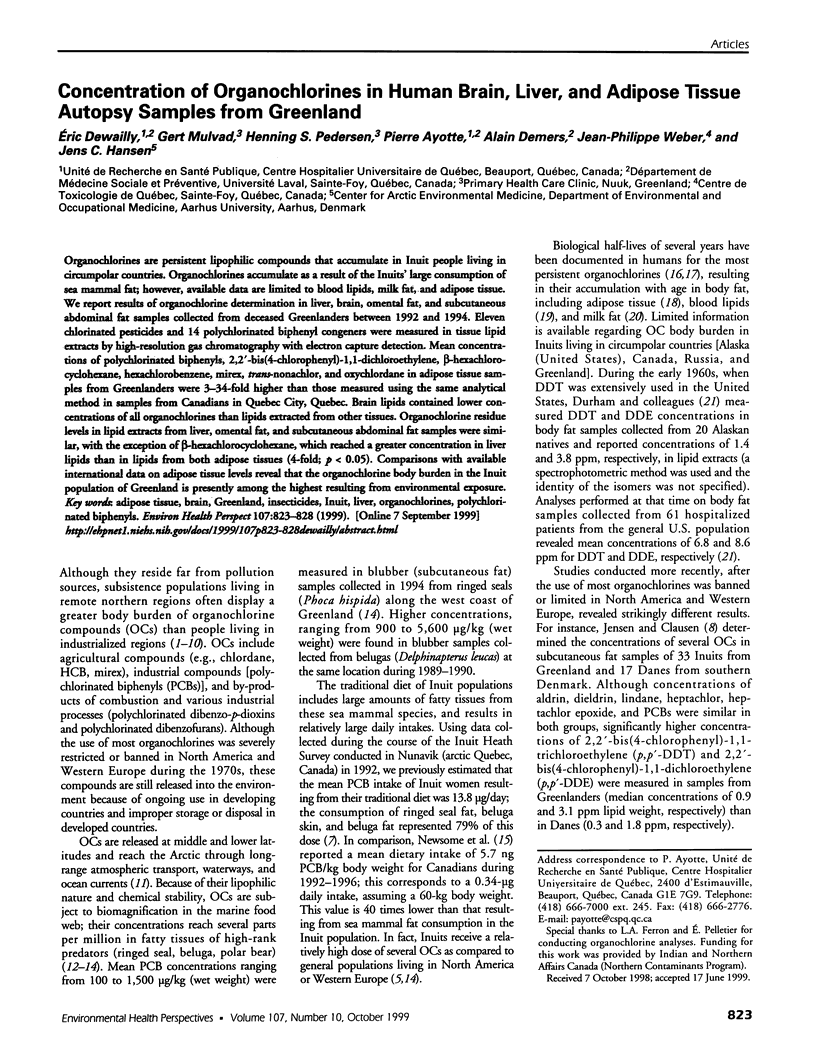
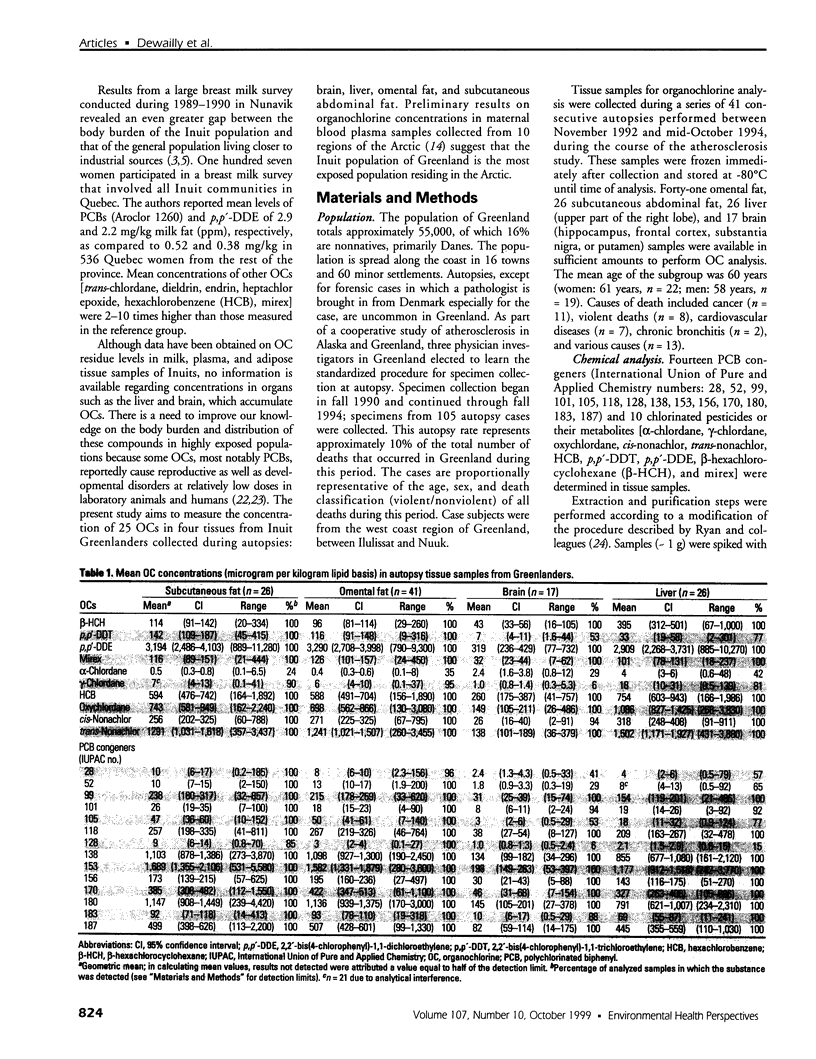
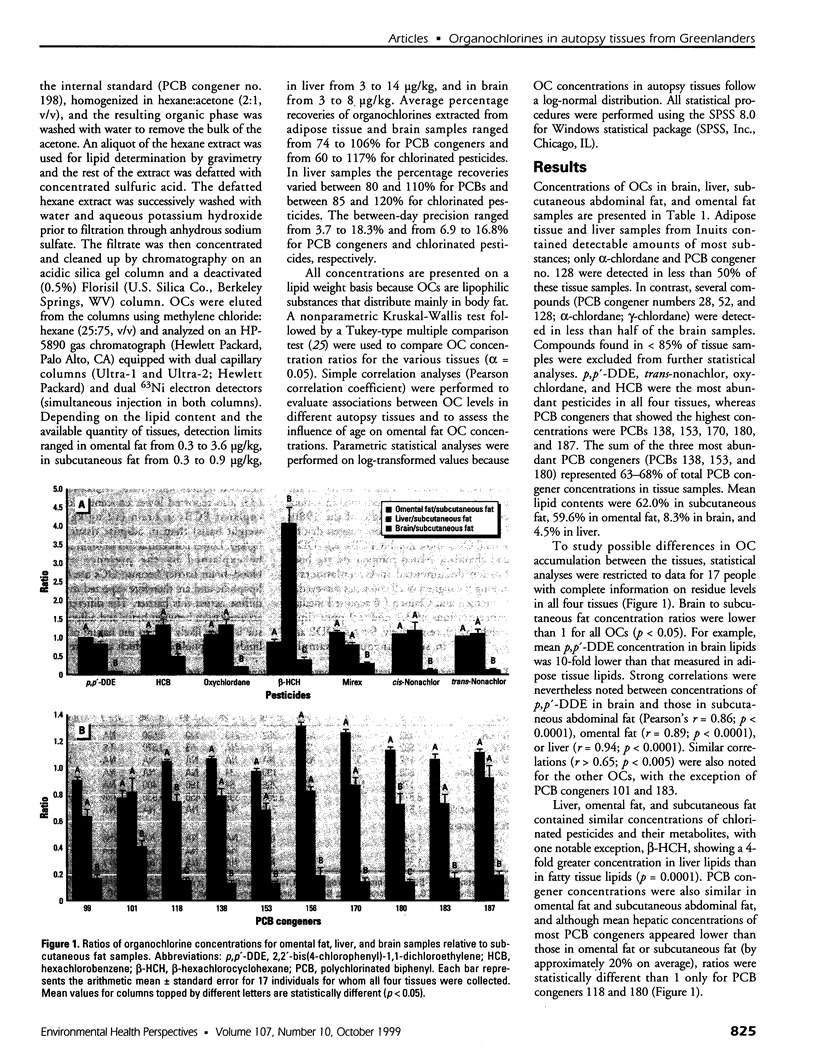
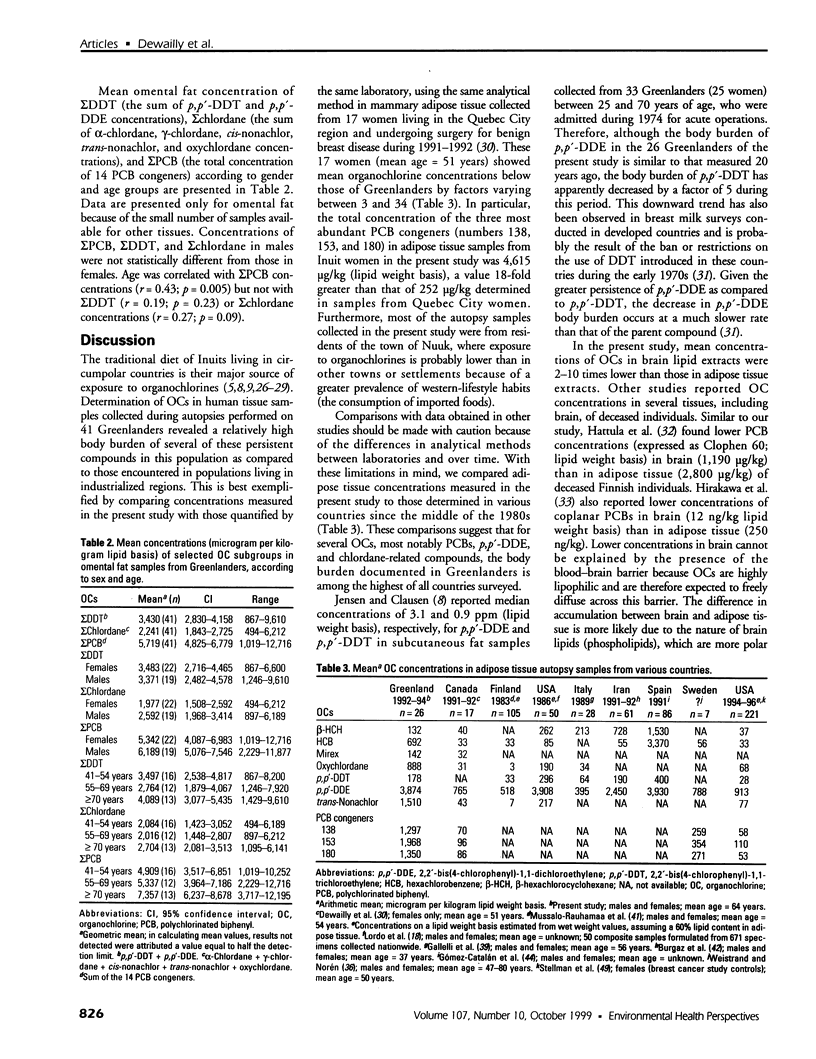
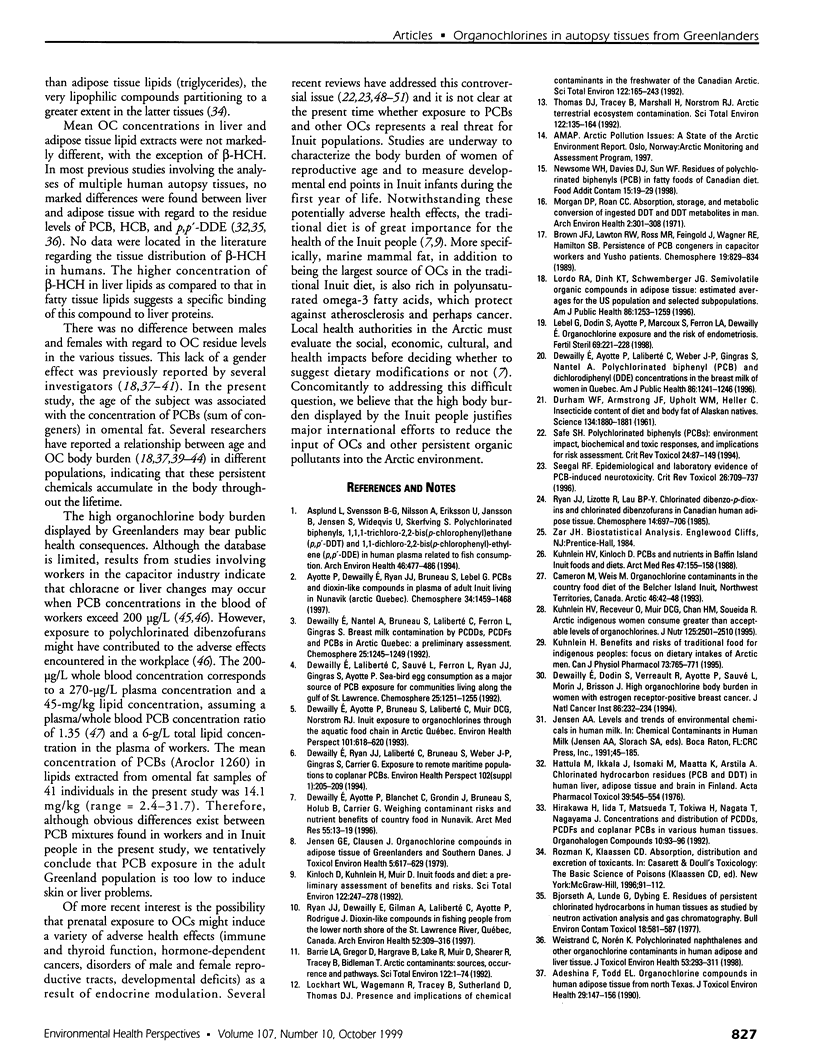

Images in this article
Selected References
These references are in PubMed. This may not be the complete list of references from this article.
- Adeshina F., Todd E. L. Organochlorine compounds in human adipose tissue from north Texas. J Toxicol Environ Health. 1990;29(2):147–156. doi: 10.1080/15287399009531379. [DOI] [PubMed] [Google Scholar]
- Asplund L., Svensson B. G., Nilsson A., Eriksson U., Jansson B., Jensen S., Wideqvist U., Skerfving S. Polychlorinated biphenyls, 1,1,1-trichloro-2,2-bis(p-chlorophenyl)ethane (p,p'-DDT) and 1,1-dichloro-2,2-bis(p-chlorophenyl)-ethylene (p,p'-DDE) in human plasma related to fish consumption. Arch Environ Health. 1994 Nov-Dec;49(6):477–486. doi: 10.1080/00039896.1994.9955004. [DOI] [PubMed] [Google Scholar]
- Ayotte P., Dewailly E., Ryan J. J., Bruneau S., Lebel G. PCBs and dioxin-like compounds in plasma of adult Inuit living in Nunavik (Arctic Quebec). Chemosphere. 1997 Mar-Apr;34(5-7):1459–1468. doi: 10.1016/s0045-6535(97)00442-6. [DOI] [PubMed] [Google Scholar]
- Barrie L. A., Gregor D., Hargrave B., Lake R., Muir D., Shearer R., Tracey B., Bidleman T. Arctic contaminants: sources, occurrence and pathways. Sci Total Environ. 1992 Jul 15;122(1-2):1–74. doi: 10.1016/0048-9697(92)90245-n. [DOI] [PubMed] [Google Scholar]
- Bjorseth A., Lunde G., Dybing E. Residues of persistent chlorinated hydrocarbons in human tissues as studied by neutron activation analysis and gas chromatography. Bull Environ Contam Toxicol. 1977 Nov;18(5):581–587. doi: 10.1007/BF01684004. [DOI] [PubMed] [Google Scholar]
- Burgaz S., Afkham B. L., Karakaya A. E. Organochlorine pesticide contaminants in human adipose tissue collected in Tebriz (Iran). Bull Environ Contam Toxicol. 1995 Apr;54(4):546–553. doi: 10.1007/BF00192598. [DOI] [PubMed] [Google Scholar]
- Camps M., Planas J., Gómez-Catalán J., Sabroso M., To-Figueras J., Corbella J. Organochlorine residues in human adipose tissue in Spain: study of an agrarian area. Bull Environ Contam Toxicol. 1989 Feb;42(2):195–201. doi: 10.1007/BF01699400. [DOI] [PubMed] [Google Scholar]
- DURHAM W. F., ARMSTRONG J. F., UPHOLT W. M., HELLER C. Insecticide content of diet and body fat of Alaskan natives. Science. 1961 Dec 8;134(3493):1880–1881. doi: 10.1126/science.134.3493.1880. [DOI] [PubMed] [Google Scholar]
- Dewailly E., Ayotte P., Blanchet C., Grondin J., Bruneau S., Holub B., Carrier G. Weighing contaminant risks and nutrient benefits of country food in Nunavik. Arctic Med Res. 1996;55 (Suppl 1):13–19. [PubMed] [Google Scholar]
- Dewailly E., Ayotte P., Bruneau S., Laliberté C., Muir D. C., Norstrom R. J. Inuit exposure to organochlorines through the aquatic food chain in arctic québec. Environ Health Perspect. 1993 Dec;101(7):618–620. doi: 10.1289/ehp.93101618. [DOI] [PMC free article] [PubMed] [Google Scholar]
- Dewailly E., Ayotte P., Laliberté C., Weber J. P., Gingras S., Nantel A. J. Polychlorinated biphenyl (PCB) and dichlorodiphenyl dichloroethylene (DDE) concentrations in the breast milk of women in Quebec. Am J Public Health. 1996 Sep;86(9):1241–1246. doi: 10.2105/ajph.86.9.1241. [DOI] [PMC free article] [PubMed] [Google Scholar]
- Dewailly E., Dodin S., Verreault R., Ayotte P., Sauvé L., Morin J., Brisson J. High organochlorine body burden in women with estrogen receptor-positive breast cancer. J Natl Cancer Inst. 1994 Feb 2;86(3):232–234. doi: 10.1093/jnci/86.3.232. [DOI] [PubMed] [Google Scholar]
- Dewailly E., Ryan J. J., Laliberté C., Bruneau S., Weber J. P., Gingras S., Carrier G. Exposure of remote maritime populations to coplanar PCBs. Environ Health Perspect. 1994 Jan;102 (Suppl 1):205–209. doi: 10.1289/ehp.94102s1205. [DOI] [PMC free article] [PubMed] [Google Scholar]
- Frank R., Rasper J., Smout M. S., Braun H. E. Organochlorine residues in adipose tissues, blood and milk from Ontario residents, 1976-1985. Can J Public Health. 1988 May-Jun;79(3):150–158. [PubMed] [Google Scholar]
- Gallelli G., Mangini S., Gerbino C. Organochlorine residues in human adipose and hepatic tissues from autopsy sources in northern Italy. J Toxicol Environ Health. 1995 Nov;46(3):293–300. doi: 10.1080/15287399509532036. [DOI] [PubMed] [Google Scholar]
- Golden R. J., Noller K. L., Titus-Ernstoff L., Kaufman R. H., Mittendorf R., Stillman R., Reese E. A. Environmental endocrine modulators and human health: an assessment of the biological evidence. Crit Rev Toxicol. 1998 Mar;28(2):109–227. doi: 10.1080/10408449891344191. [DOI] [PubMed] [Google Scholar]
- Gómez-Catalán J., Lezaun M., To-Figueras J., Corbella J. Organochlorine residues in the adipose tissue of the population of Navarra (Spain). Bull Environ Contam Toxicol. 1995 Apr;54(4):534–540. doi: 10.1007/BF00192596. [DOI] [PubMed] [Google Scholar]
- Hattula M. L., Ikkala J., Isomäki M., Mättä K., Arstila A. U. Chlorinated hydrocarbon residues (PCB and DDT) in human liver, adipose tissue and brain in Finland. Acta Pharmacol Toxicol (Copenh) 1976;39(5):545–554. doi: 10.1111/j.1600-0773.1976.tb03204.x. [DOI] [PubMed] [Google Scholar]
- Holladay S. D., Luster M. I. Alterations in fetal thymic and liver hematopoietic cells as indicators of exposure to developmental immunotoxicants. Environ Health Perspect. 1996 Aug;104 (Suppl 4):809–813. doi: 10.1289/ehp.96104s4809. [DOI] [PMC free article] [PubMed] [Google Scholar]
- Jensen G. E., Clausen J. Organochlorine compounds in adipose tissue of Greenlanders and southern Danes. J Toxicol Environ Health. 1979 Jul;5(4):617–629. doi: 10.1080/15287397909529774. [DOI] [PubMed] [Google Scholar]
- Kinloch D., Kuhnlein H., Muir D. C. Inuit foods and diet: a preliminary assessment of benefits and risks. Sci Total Environ. 1992 Jul 15;122(1-2):247–278. doi: 10.1016/0048-9697(92)90249-r. [DOI] [PubMed] [Google Scholar]
- Kuhnlein H. V. Benefits and risks of traditional food for Indigenous Peoples: focus on dietary intakes of Arctic men. Can J Physiol Pharmacol. 1995 Jun;73(6):765–771. doi: 10.1139/y95-102. [DOI] [PubMed] [Google Scholar]
- Kuhnlein H. V., Kinloch D. PCB's and nutrients in Baffin Island Inuit foods and diets. Arctic Med Res. 1988;47 (Suppl 1):155–158. [PubMed] [Google Scholar]
- Kuhnlein H. V., Receveur O., Muir D. C., Chan H. M., Soueida R. Arctic indigenous women consume greater than acceptable levels of organochlorines. J Nutr. 1995 Oct;125(10):2501–2510. doi: 10.1093/jn/125.10.2501. [DOI] [PubMed] [Google Scholar]
- Kuwahara M., Tokiwa M., Orikasa Bacterial infection and acid mucopolysaccharides in epithelium of rat urinary bladder. Urol Res. 1982;10(2):93–96. doi: 10.1007/BF00262410. [DOI] [PubMed] [Google Scholar]
- Lebel G., Dodin S., Ayotte P., Marcoux S., Ferron L. A., Dewailly E. Organochlorine exposure and the risk of endometriosis. Fertil Steril. 1998 Feb;69(2):221–228. doi: 10.1016/s0015-0282(97)00479-2. [DOI] [PubMed] [Google Scholar]
- Lockhart W. L., Wagemann R., Tracey B., Sutherland D., Thomas D. J. Presence and implications of chemical contaminants in the freshwaters of the Canadian Arctic. Sci Total Environ. 1992 Jul 15;122(1-2):165–245. doi: 10.1016/0048-9697(92)90248-q. [DOI] [PubMed] [Google Scholar]
- Lordo R. A., Dinh K. T., Schwemberger J. G. Semivolatile organic compounds in adipose tissue: estimated averages for the US population and selected subpopulations. Am J Public Health. 1996 Sep;86(9):1253–1259. doi: 10.2105/ajph.86.9.1253. [DOI] [PMC free article] [PubMed] [Google Scholar]
- Mes J., Marchand L., Davies D. J. Organochlorine residues in adipose tissue of Canadians. Bull Environ Contam Toxicol. 1990 Nov;45(5):681–688. doi: 10.1007/BF01700986. [DOI] [PubMed] [Google Scholar]
- Morgan D. P., Roan C. C. Absorption, storage, and metabolic conversion of ingested DDT and DDT metabolites in man. Arch Environ Health. 1971 Mar;22(3):301–308. doi: 10.1080/00039896.1971.10665848. [DOI] [PubMed] [Google Scholar]
- Mussalo-Rauhamaa H., Pyysalo H., Moilanen R. Influence of diet and other factors on the levels of organochlorine compounds in human adipose tissue in Finland. J Toxicol Environ Health. 1984;13(4-6):689–704. doi: 10.1080/15287398409530532. [DOI] [PubMed] [Google Scholar]
- Newsome W. H., Davies D. J., Sun W. F. Residues of polychlorinated biphenyls (PCB) in fatty foods of the Canadian diet. Food Addit Contam. 1998 Jan;15(1):19–29. doi: 10.1080/02652039809374596. [DOI] [PubMed] [Google Scholar]
- Peterson R. E., Theobald H. M., Kimmel G. L. Developmental and reproductive toxicity of dioxins and related compounds: cross-species comparisons. Crit Rev Toxicol. 1993;23(3):283–335. doi: 10.3109/10408449309105013. [DOI] [PubMed] [Google Scholar]
- Ryan J. J., Dewailly E., Gilman A., Laliberté C., Ayotte P., Rodrigue J. Dioxin-like compounds in fishing people from the Lower North Shore of the St. Lawrence River, Quebec, Canada. Arch Environ Health. 1997 Jul-Aug;52(4):309–316. doi: 10.1080/00039899709602204. [DOI] [PubMed] [Google Scholar]
- Safe S. H. Polychlorinated biphenyls (PCBs): environmental impact, biochemical and toxic responses, and implications for risk assessment. Crit Rev Toxicol. 1994;24(2):87–149. doi: 10.3109/10408449409049308. [DOI] [PubMed] [Google Scholar]
- Seegal R. F. Epidemiological and laboratory evidence of PCB-induced neurotoxicity. Crit Rev Toxicol. 1996 Nov;26(6):709–737. doi: 10.3109/10408449609037481. [DOI] [PubMed] [Google Scholar]
- Stellman S. D., Djordjevic M. V., Muscat J. E., Gong L., Bernstein D., Citron M. L., White A., Kemeny M., Busch E., Nafziger A. N. Relative abundance of organochlorine pesticides and polychlorinated biphenyls in adipose tissue and serum of women in Long Island, New York. Cancer Epidemiol Biomarkers Prev. 1998 Jun;7(6):489–496. [PubMed] [Google Scholar]
- Thomas D. J., Tracey B., Marshall H., Norstrom R. J. Arctic terrestrial ecosystem contamination. Sci Total Environ. 1992 Jul 15;122(1-2):135–164. doi: 10.1016/0048-9697(92)90247-p. [DOI] [PubMed] [Google Scholar]
- Weistrand C., Norén K. Polychlorinated naphthalenes and other organochlorine contaminants in human adipose and liver tissue. J Toxicol Environ Health A. 1998 Feb 20;53(4):293–311. doi: 10.1080/009841098159295. [DOI] [PubMed] [Google Scholar]



